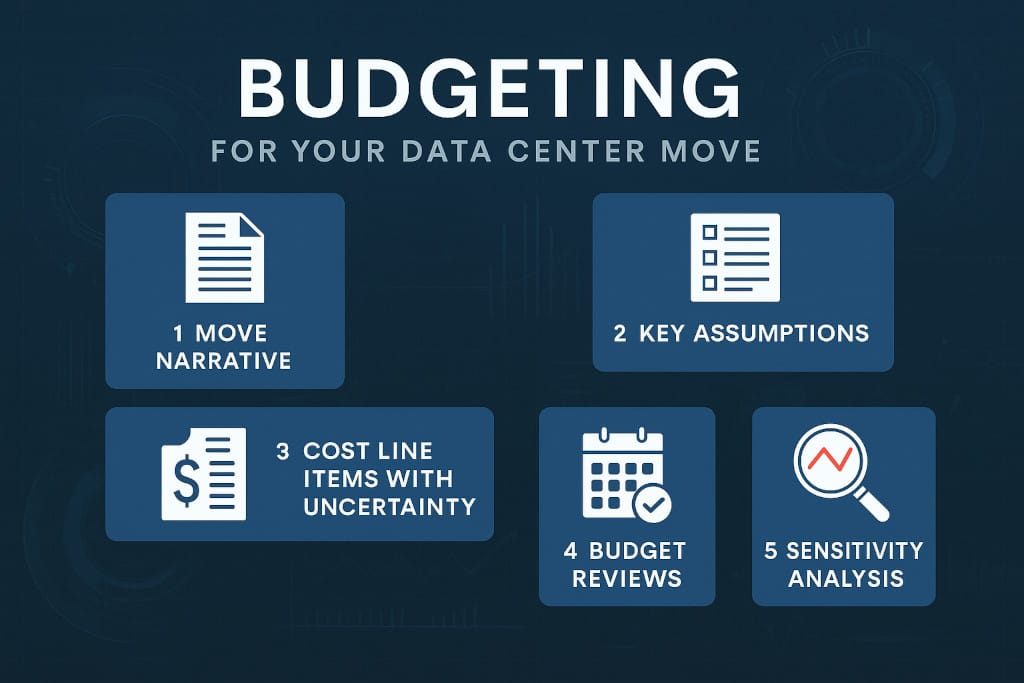Your governance team is in place — now it’s time to talk numbers. Here’s how to build a realistic, flexible budget you can defend.
In our previous post, Who’s in Charge? Governance in Your Data Center Move, we emphasized the importance of leadership and accountability. With your governance structure in place, the next step is one of the most critical — and most misunderstood:
Budgeting.
“How much is this move going to cost?” is the question everyone asks. And yet, it’s nearly impossible to answer early in the process with total accuracy. Budgeting for a data center move isn’t about guessing — it’s about building a clear, evolving model that matches your move narrative, priorities, and unknowns.
This post — Part 1 of our budgeting series — covers the foundations of building a realistic, responsible cost model.
Why Budgeting Is So Challenging (and So Important)
Budgeting for a data center move is one of the most frustrating parts of the process. Early on, you’re working with incomplete information, undefined scope, and often, pressure from executives to “just give me a number.”
Unfortunately, there’s no reliable “cost per square foot” or “cost per device” model that works across all projects. Every data center move is unique. Your costs will depend on:
- The size and complexity of your infrastructure
- How you sequence the move
- Who’s doing the work
- Your downtime tolerance
- The accuracy of your Move Narrative
As your move plan evolves, so will your numbers. That’s normal. The key is to start early with a flexible, realistic budgeting process.
The #1 Mistake: Assumption Errors
The most expensive budgeting mistake is assuming your budget model is complete.
Here are some costly assumptions that sabotage data center move budgets:
- Thinking staff can handle the move on top of their full-time jobs
- Believing a holiday weekend move will automatically reduce risk or cost
- Overlooking hidden costs like new cabling, testing, or overtime
- Forgetting about the cost of budgeting itself
The takeaway? Budgeting is not just about numbers — it’s about assumptions. And unchecked assumptions can get expensive fast.
What Makes a Successful Data Center Move Budget?
Here’s what should be included in your initial cost model:
✅ 1. A Documented Move Narrative
Lay out the scope, goals, and sequence of your move in plain language. This becomes the foundation of your cost plan.
✅ 2. A List of Key Assumptions
List all the assumptions you’re making — including staffing, timing, hardware reuse, third-party vendors, etc.
✅ 3. Budget Line Items with Confidence Ratings
Pair each budget line with an “uncertainty level” so you know which figures are likely to shift.
✅ 4. A Gap Analysis Plan
Build in checkpoints to review what’s missing or miscalculated in your initial estimates.
Don’t Overlook the Cost of Budgeting Itself
Budgeting is a phase — and it has its own resource and time requirements. Be sure to include:
- Internal budget review meetings
- Ongoing budget revisions and updates
- Sensitivity analysis (best-case/worst-case scenarios)
- Training sessions to help teams understand cost components
- Help from internal or external advisors to build early costing models
Accept the Reality of Imperfect Data
No matter how well you plan, you’ll never have 100% of the data you want when it’s time to present a number. The solution isn’t to delay — it’s to build a budgeting process that’s dynamic and adaptive.
Review your budget regularly. Revisit your assumptions. Update your cost model as more information becomes available.
Need Help Building a Realistic Cost Model?
At Electronic Transport Corporation, we’ve helped hundreds of companies build and refine their data center move budgets. From early-stage planning to final cost tracking, we guide you through the budgeting phase with clarity and control.
📞 Call us today or 📧 email us to schedule a No Obligation Consultation for your next data center move. Let’s put your budget on the right track — from Day One.


0 Comments